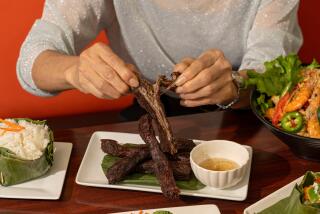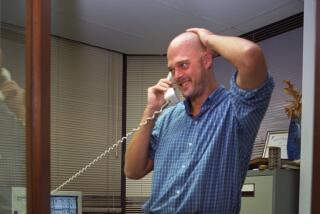Vacation Memories : Getting a Scoop on the Road to ‘New’ Mandalay
- Share via
As it turned out, a visit to Rangoon’s Golden Pagoda that towers 326 feet above that Oriental city was the only redeeming feature of the “return to Burma” I had planned following the Olympics in Tokyo in the autumn of 1964.
A journalistic scoop also helped ease the pain of being denied the trip I had planned through Bhamo, Lashio, Myithyina, Shaduzup, Warazup, etc., all blood-stained blotches along the tortuous trace of the Stilwell Road I had journeyed during World War II, a trail carved through the mountainous jungles of north Burma against bitter resistance from the Japanese.
In spite of my travel agent’s efforts, the best I could get was a 24-hour “travel through Rangoon” visa.
In Hong Kong I had complained at a cocktail party to Frank McCulloch, Asia bureau chief for Time and Life, and he was dismayed.
“You have a visa into Rangoon?” he almost shouted at me. “The new Communist government hasn’t let a news correspondent from the United States, Canada or England into Burma for more than six months!”
Then he told me that a fraternity brother was with the American Embassy in Rangoon and that through “diplomatic pouch” he would tell him I was coming.
It was with misgivings that my wife and I checked with customs after our Air India plane touched down at Rangoon. Several Americans were waiting. They told us they were a Watchtower Evangelical group; having been denied permission to leave the airport, they were ordered to leave on the next available plane.
Customs accepted our visas without question; our guide arrived and whisked us to the Soviet-built Inya Lake Hotel in his ancient Chevy. “To be frank with you, our new government is discouraging tourists,” he said, “but have no fear, everything is arranged for the trip to the Golden Pagoda tomorrow morning.”
In the empty lobby a clerk checked us in. We were led down a deserted corridor on the second floor, told good night and left inside a monstrosity of a room. The bathtub was huge and, thank goodness, the water was hot.
Dining Alone
Refreshed, we made our way into a cavernous dining room where a scattering of Burmese and Soviets were dining. We were conspicuously alone.
A loudspeaker blared forth with a scratchy rendition by Debbie Reynolds of “Tammy,” and our dinner menu had one entry--”Paprika Chicken-Hungarian.”
This was our introduction to Burma.
Next morning, as we climbed the seemingly endless steps of the Swedagon pagoda, it occurred to me that W. Somerset Maugham exaggerated a bit when he said its golden spires “rise like a sudden hope in the dark night of the soul.” Inspiring? Hardly that much.
The 2,500-year-old pagoda has been described as an “architectural masterpiece” and is awesome with its “spires of gold and diamonds.” Somehow, though, I couldn’t banish from my mind a picture of the bombed-out pagodas along the Stilwell Road many leagues north.
Rudyard Kipling’s “smiling, dusky Burmese maidens . . . smoking whacking white cheroots” were busy selling their product at numerous stands, a pleasant relief from the saffron-cloaked monks who abounded, seeking alms.
Following the Golden Pagoda tour, Bob Mount of the embassy met me at the bar. “The beer’s good,” he said. Mount related a sanguine story of the Communist regime under Gen. Ne Win. When I asked about north Burma, Mount said: “The truth is, Gen. Win’s government doesn’t try to rule beyond Mandalay.
“Nobody tries to control the wild tribes to the north--especially the Kachins. They are a law unto themselves.
“The Stilwell Road? Much of it has been overgrown by jungle. The remaining traces are used only to ply the opium trade.
Expulsion of Hindus
“Presently Gen. Win seems to be preoccupied with driving the Hindus back to India, including some of Rangoon’s top merchants. When you get to the airport to meet your Calcutta plane, you will see a sight you will not believe.
“I’ll meet you there.”
Hindus crowded the lobby when we arrived: women in silk saris with expensive luggage, lower castes with cardboard suitcases and bags of cooking utensils.
They were in long lines, patiently waiting their turns as customs officials slashed the linings of cases and slit the hems of expensive clothing seeking possible smuggled jewelry and gems.
Mount met us at customs. He reached over my shoulder and handed the officer a box, saying it contained some Burma cheroots to “declare with their baggage.” While carnage to Indian luggage went madly on around us, ours went through untouched.
After a 90-minute delay we boarded our jet and heaved a huge sigh of relief as the plane climbed over the water and headed for Calcutta.
Despite the memory of a scary takeoff from DumDum Airport during World War II, our arrival on Indian soil was a relief.
Tall, Cool Drinks
In the sanctuary of our air-conditioned room at the Grand Hotel we had tall, cool drinks before I sat down to write the first news story to come out of Burma in almost a year. It appeared on the front page of the Los Angeles Times, Sunday, Nov. 15, 1964.
In the Grand Hotel dining room that night, Charlotte looked up from the expansive menu, grinned at me and said:
“Just think, only yesterday we had dinner at the Inya Lake hotel in Rangoon and all we could get was paprika chicken-Hungarian.”
We enjoyed a hearty laugh and a dinner to match.
Six months later the New York Times, in all its majesty, announced “the first story out of Burma in over a year.”
But they’d been scooped.
More to Read
Sign up for The Wild
We’ll help you find the best places to hike, bike and run, as well as the perfect silent spots for meditation and yoga.
You may occasionally receive promotional content from the Los Angeles Times.






